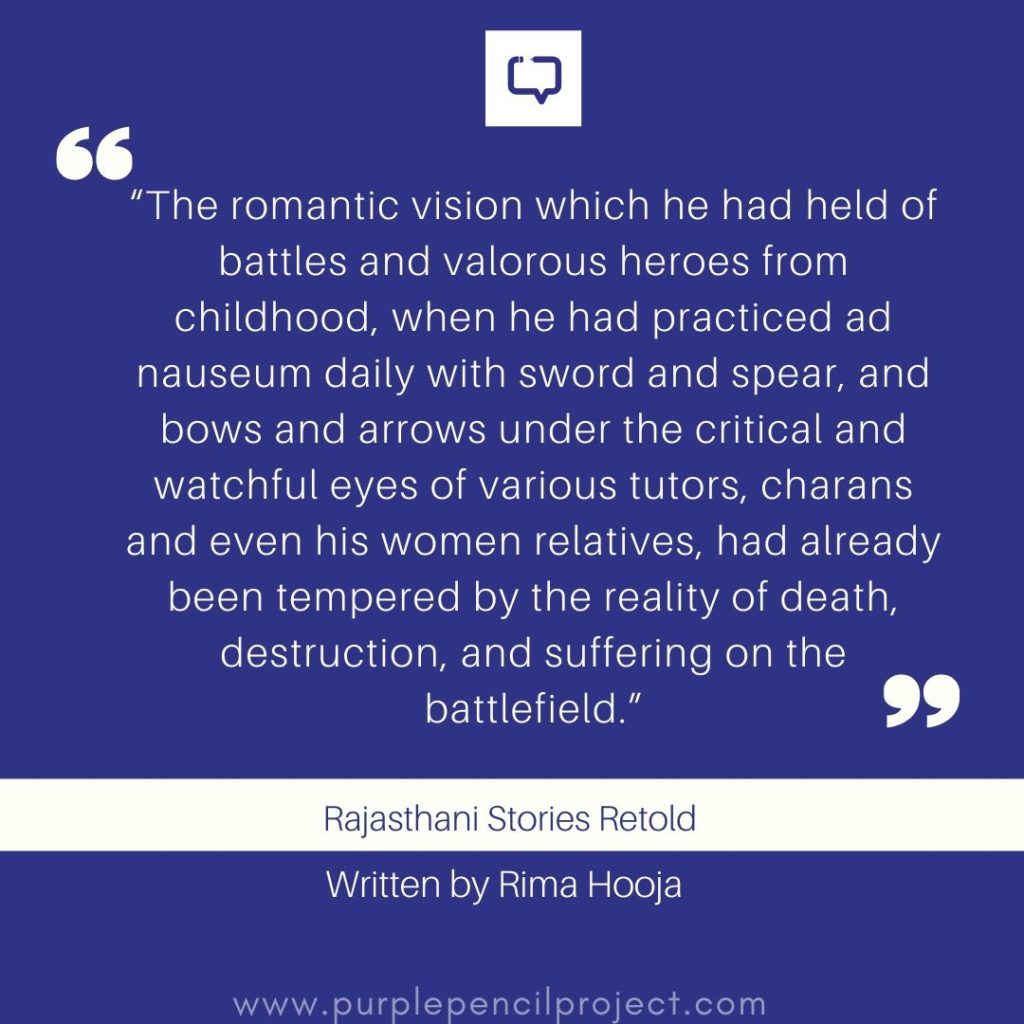Golden sands, forts, colourful dresses, rich culture, the Rajputs. These are some of the images I have always associated with Rajasthan. With its colourful history and rich heritage, Rajasthan has also been one of the most fertile regions from where stories of valour, courage and wonderful achievements have sprung. Rajasthani Stories Retold by Rima Hooja is a collection that tells, or rather, re-tells some of these stories.
We encourage you to buy books from a local bookstore. If that is not possible, please use the links on the page and support us. Thank you.
The stories in this collection are the stories of Rajput warriors and reflect their aan-baan-shaan in various situations and reveal how this code of glory governed all aspects of their life. In her introduction to the book, Rima Hooja writes:
[these are] tales of heroism, the self and the State, that stern old-fashioned task master called ‘Duty’, and on sacrifice, warfare and the human spirit and the world the warriors of Rajasthan belonged to.
The nine stories collected in Rajasthani Stories Retold all follow these themes in one way or the other.
Of Sacrifice and Kindness
Most stories in Rajasthani Stories Retold feature kings, queens and warriors and present them before the reader in some of the most difficult and conflicting moments of their lives. Times when they seem to be standing on the edge of a precipice and have to make a decision that will make or break them as well as the clan that depends on them for their welfare.
The Mother tells the readers of the sacrifice of Manek Bai, the Prince of Sirohi’s wet nurse, who makes the greatest sacrifice a mother can in order to save the life of the prince as a sudden coup takes place in the royal palace. Two Kings of Shrimal is the story of a different kind of strength of the king of the rich town of Shrimal whose heart is changed by a Jain mendicant but whose son does not agree with the father’s change of heart.
The Teacher is yet another short tale which reveals the virtue of humility and the value of a teacher through the experiences of the young Maharaja Jai Singh of Dhoondhar. Napa Sankhala and Prince Bika’s Journey is the account of how the city and the kingdom of Bikaner were founded and Napa Sankhala’s role in it.
The Games of Thrones
Battle Honours is a shorter and crisp story that presents the Rajputi shaan in all its resplendence as we witness the fifteen-year-old Prince Aniruddha of Bundi win the admiration of emperor Aurangzeb not just by his exceptional skills at the battlefield but also the way he conducts himself before Aurangzeb after the battle is over.
Lumbha and the King Parmar takes its readers to a chapter in history as we witness how Lumbha won over the Parmar kingdom by his sheer cunning even as he flouts the norms of battle to fulfil his responsibility of providing land and kingdom for his family and his followers.
Umaid Singh – The Shri-ji of Bundi is the story of Umaid Singh who is requested to return to Bundi by his faithful followers after he has abdicated the throne in favour of his grandson and retired to Varanasi.
Narasimha – A Tiger Tale is the interesting story of Raja Dwarka Das who is asked to wrestle with a tiger by the Mughal emperor in his court while the last story of the collection, Jaswant Singh of Marwar and Queen Hadi Ji reveals how the decree of valour in the battlefield is a deciding factor in the welcome a Rajput receives as he returns home.
Folktale or Not?
While the nine stories in Rajasthani Stories Retold could be defined as folktales because they have belonged to the masses and have been told and re-told with additions and embellishments across time, most of them stay firmly rooted in history. They might be fictional re-tellings of real events, but Rima Hooja takes pains to let her readers know that these tales have their grounding in real people and real events.
After every story, we are given a page or two of notes where Rima Hooja gives the historical background to the story and its people, places and events. She situates these with dates, names and places and at times also offers her readers the exact sources which she has used for her research and writing. This cross between a critical edition and a novel is a refreshing presentation of the stories.
She uses Hindi/Rajasthani words in her stories from time to time and provides the English meanings in brackets. While some words like Dai-Ma, janapada, charan, mahua, raola etc. add to the flavour of the book, some others like mashaal, gaddi, raja, shikar etc. feel replaceable by their English equivalents, without any great loss to the story.
The stories in Rajasthani Stories Retold come in varying lengths. While the shorter stories are crisp, to the point and successful in holding the interest of the reader, the same cannot be said for all the longer stories in the book. This is primarily because the shorter stories – like Battle Honours, The Teacher and Narasimha – are action based and fictionalise a particular moment whereas some of the longer ones like The Two Kings of Shrimal, Umaid Singh – The Shri-ji of Bundi and Napa Sankhala and Prince Bika’s Journey – deal with a longer period of time and achievements.
And, because Rima Hooja chooses to go into great detail about the past before coming to the present moment of action, these stories can sometimes read like a lesson from a history textbook.
Details of the past upheavals of a kingdom, the names of many Kings who belonged to a particular clan and their history (like in the stories Umaid Singh; Napa Sankhala and even Lumbha and King Parmar) or even long descriptions of a place (like in The Two Kings of Shrimal) can prove taxing to a lay reader who might not be very interested in knowing such historical details. The action-based stories, on the other hand, read very well and engage the reader as we see a moment in history crystallize before us.
A word for the cover design which gives its readers an idea of what to expect from the stories. The painting of a rich and colourful Rajput procession on the cover fits well with the themes of these stories.
Go for this collection if you have an interest in Rajasthan and want to know about those warriors and those tales that are not very popular outside the state. And if you are a history buff as well, Rajasthani Stories Retold will definitely delight you.
Final Verdict: 3.5 stars
Favourite Quote by Rima Hooja:























2 Responses
These tales deeply rooted in history sure sound interesting. Lovely review Sneha !
Thanks Divya! You are spot-on in saying that these are tales steeped in history of the region.